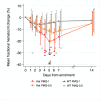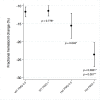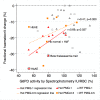Haemolysis in G6PD Heterozygous Females Treated with Primaquine for Plasmodium vivax Malaria: A Nested Cohort in a Trial of Radical Curative Regimens
- PMID: 28170391
- PMCID: PMC5295665
- DOI: 10.1371/journal.pmed.1002224
Haemolysis in G6PD Heterozygous Females Treated with Primaquine for Plasmodium vivax Malaria: A Nested Cohort in a Trial of Radical Curative Regimens
Abstract
Background: Radical cure of Plasmodium vivax malaria with 8-aminoquinolines (primaquine or tafenoquine) is complicated by haemolysis in individuals with glucose-6-phosphate dehydrogenase (G6PD) deficiency. G6PD heterozygous females, because of individual variation in the pattern of X-chromosome inactivation (Lyonisation) in erythroid cells, may have low G6PD activity in the majority of their erythrocytes, yet are usually reported as G6PD "normal" by current phenotypic screening tests. Their haemolytic risk when treated with 8-aminoquinolines has not been well characterized.
Methods and findings: In a cohort study nested within a randomised clinical trial that compared different treatment regimens for P. vivax malaria, patients with a normal standard NADPH fluorescent spot test result (≳30%-40% of normal G6PD activity) were randomised to receive 3 d of chloroquine or dihydroartemisinin-piperaquine in combination with primaquine, either the standard high dose of 0.5 mg base/kg/day for 14 d or a higher dose of 1 mg base/kg/d for 7 d. Patterns of haemolysis were compared between G6PD wild-type and G6PD heterozygous female participants. Between 21 February 2012 and 04 July 2014, 241 female participants were enrolled, of whom 34 were heterozygous for the G6PD Mahidol variant. Haemolysis was substantially greater and a larger proportion of participants reached the threshold of clinically significant haemolysis (fractional haematocrit reduction >25%) in G6PD heterozygotes taking the higher (7 d) primaquine dose (9/17 [53%]) compared with G6PD heterozygotes taking the standard high (14 d) dose (2/16 [13%]; p = 0.022). In heterozygotes, the mean fractional haematocrit reductions were correspondingly greater with the higher primaquine dose (7-d regimen): -20.4% (95% CI -26.0% to -14.8%) (nadir on day 5) compared with the standard high (14 d) dose: -13.1% (95% CI -17.6% to -8.6%) (nadir day 6). Two heterozygotes taking the higher (7 d) primaquine dose required blood transfusion. In wild-type participants, mean haematocrit reductions were clinically insignificant and similar with both doses: -5.8 (95% CI -7.2% to -4.4%) (nadir day 3) compared with -5.5% (95% CI -7.4% to -3.7%) (nadir day 4), respectively. Limitations to this nested cohort study are that the primary objective of the trial was designed to measure efficacy and not haemolysis in relation to G6PD genotype and that the heterozygote groups were small.
Conclusion: Higher daily doses of primaquine have the potential to cause clinically significant haemolysis in G6PD heterozygous females who are reported as phenotypically normal with current point of care tests.
Trial registration: ClinicalTrials.gov NCT01640574.
Conflict of interest statement
The authors have declared that no competing interests exist.
Figures




References
-
- Beutler E. The hemolytic effect of primaquine and related compounds: a review. Blood. 1959;14: 103–139. - PubMed
-
- Beutler E, Mitchell M. Special modifications of the fluorescent screening method for glucose-6-phosphate dehydrogenase deficiency. Blood, J Hematol. 1968;32: 816–818. - PubMed
-
- Luzzatto L. Glucose 6-phosphate dehydrogenase deficiency: from genotype to phenotype. Hematol J. 2006;91: 1303–1306. - PubMed
Publication types
MeSH terms
Substances
Associated data
LinkOut - more resources
Full Text Sources
Other Literature Sources
Medical
Miscellaneous

